 Mature and Dors pair up for a bloc buster thriller. 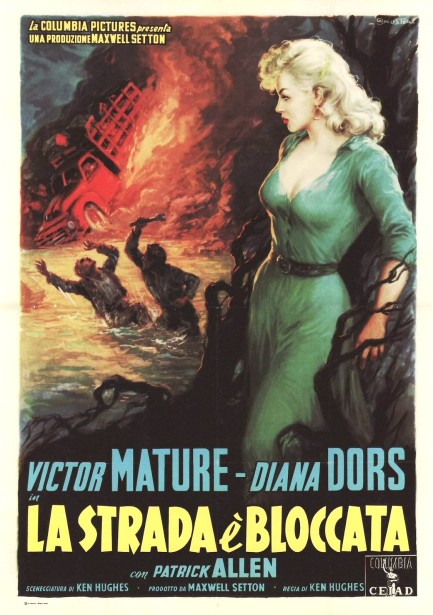
The 1957 Victor Mature/Diana Dors vehicle The Long Haul premiered in Italy today in 1958 as La strada è bloccata, which means “the road is blocked.” The art here is by Italian illustrator Anselmo Ballester. This is one of his better efforts, we think, with his Dors figure reflecting light from some off-canvas source, while a fire lights the background. You can see more from him here and here. As for the movie, we talked about it a while ago. You can read our thoughts here. And you can see a cool Japanese poster for the film here.
 Victor Mature offers a ride and accidentally opens a Dors to big trouble. 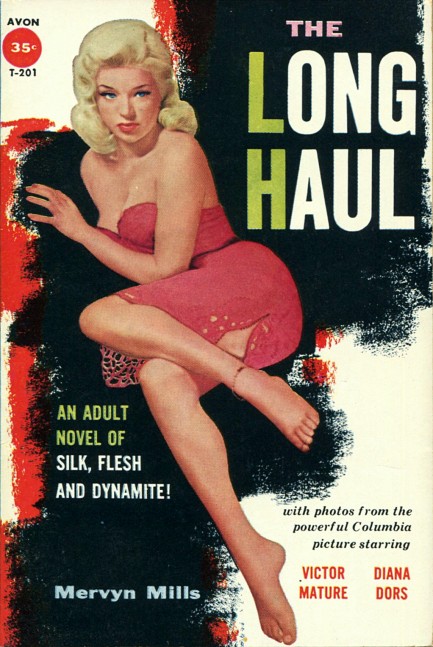 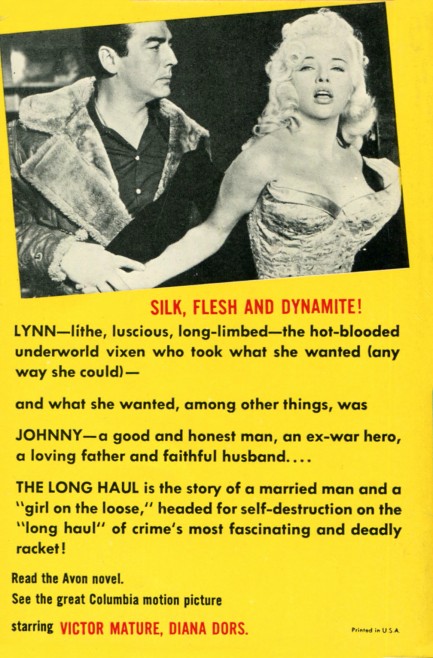
Above is a nice cover for the movie tie-in edition from Avon Publications of The Long Haul by Mervyn Mills, which is about a trucker who gives a ride to a gangster's moll and as a result has to deal with numerous life threatening problems. It was published in 1957 and immediately adapted to the big screen, with the movie starring Victor Mature and Diana Dors appearing the next year. The art on this, which we think is great, is modeled after the movie poster and is unattributed, possibly because it's a photo-illustration, though we can't 100% sure on that.
 Victor Mature goes one blonde over the recommended limit. 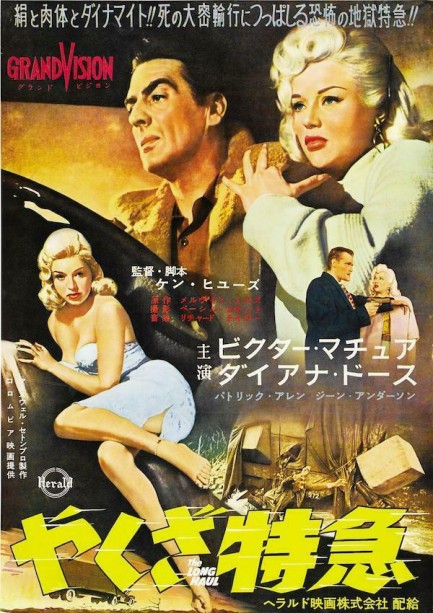
This Japanese poster was made to promote the Victor Mature/Diana Dors drama The Long Haul, which deals with a truck driver who discovers that his outfit is in the grip of organized crime. For that reason the film was given the Japanese title Yakuza tokkyū, or “Yakuza express.” Our favorite part of the poster are little speed lines on the title. This one does move pretty fast, as we mentioned last year, and Dors makes a particularly tempting femme fatale. After opening in England in 1957 The Long Haul premiered in Japan today in 1959.
 Victor Mature transports hot merchandise. 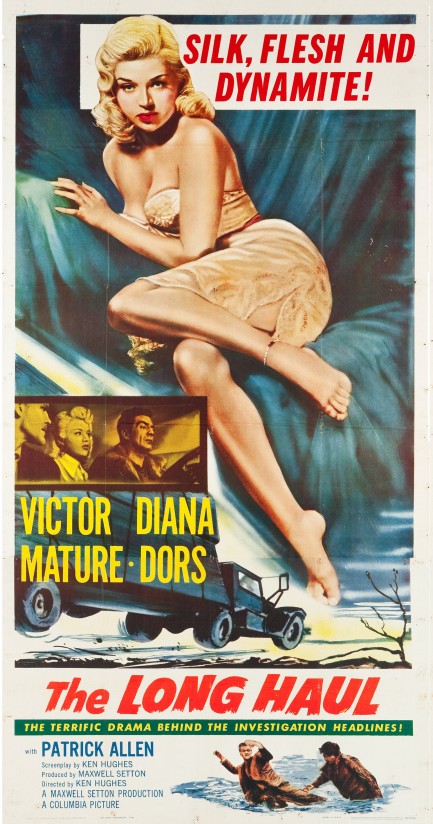
One good Victor Mature movie deserves another. Mr. M impressed us so much in Kiss of Death we decided to watch another of his early films. The amazing poster above was made to promote his crime thriller The Long Haul, which is set in Britain and concerns an American ex-soldier who takes a trucking job only to run afoul of an organized-crime syndicate that controls the trucking industry. British star Diana Dors plays the glamorous girlfriend of one of the mobsters, and after a couple's spat she ends up in Mature's truck begging him to drive her to safety. This turns out to be a dangerous decision in two areas—his health, and his marriage.
Because The Long Haul was originally made in Britain it's a bit more frank than the typical American film concerning matters of sex and marriage. There's no vagueness about Mature and Dors doing the mattress dance, which we found refreshing. The family drama sections of crime movies are often throw-ins, but here Mature's marital difficulties really help drive the plot. In the end he needs to deal with these issues, but he also, naturally, has to survive crossing the mob boss, who's not sanguine about losing Dors, nor about other transgressions committed by Mature. It's trouble on two fronts, which makes for a pretty good movie. Decent work from Mature. The Long Haul premiered in Britain today in 1957.
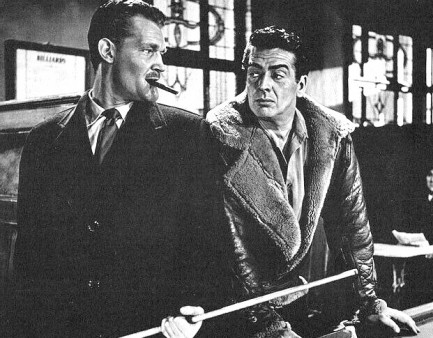 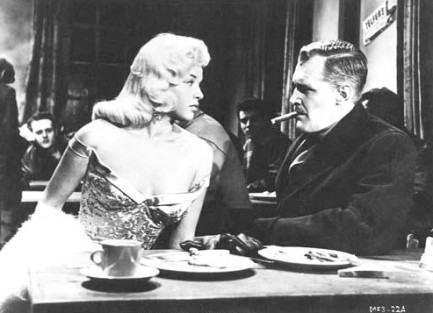 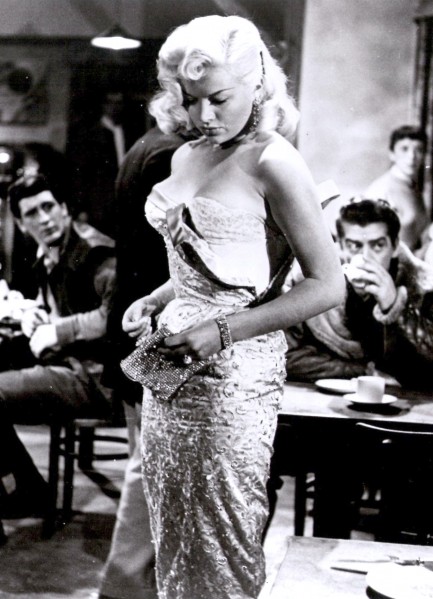 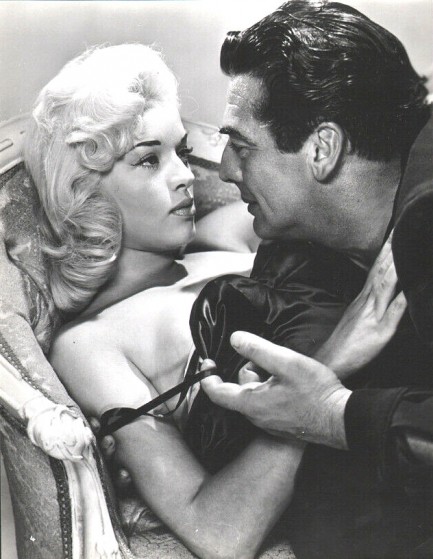 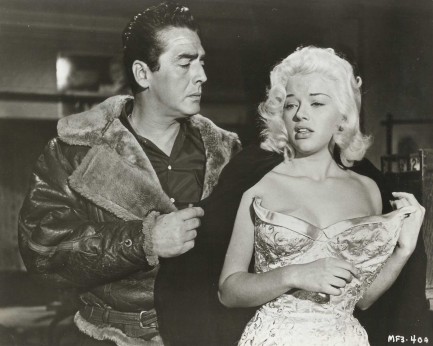 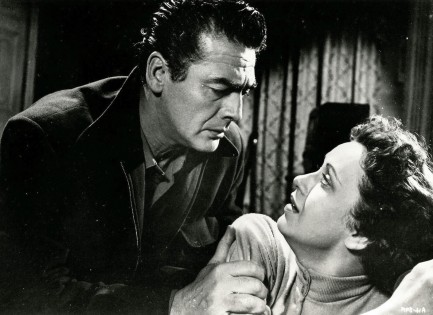 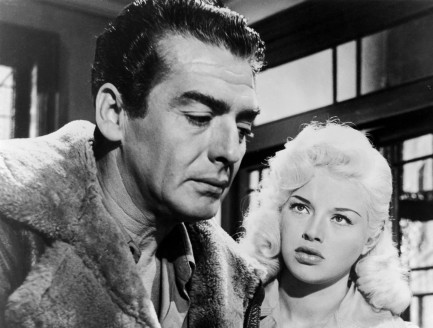 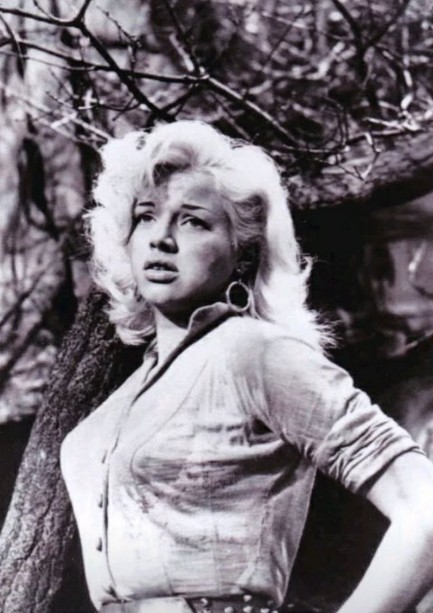 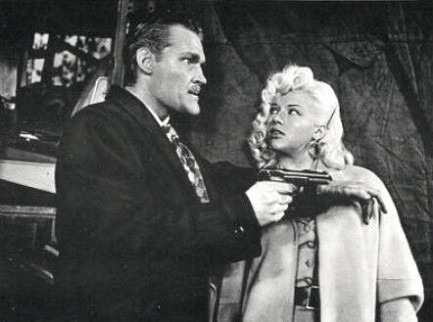 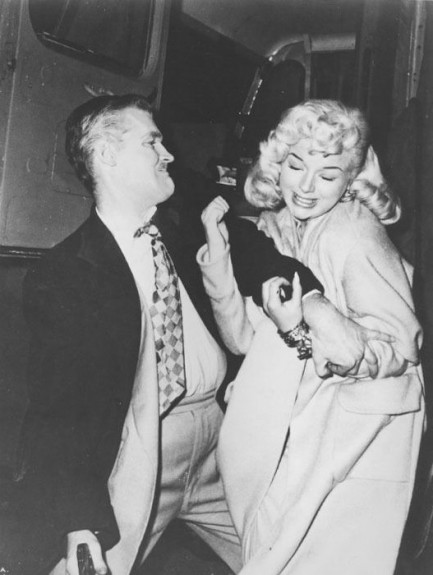 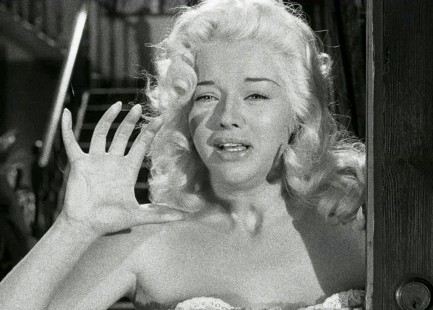 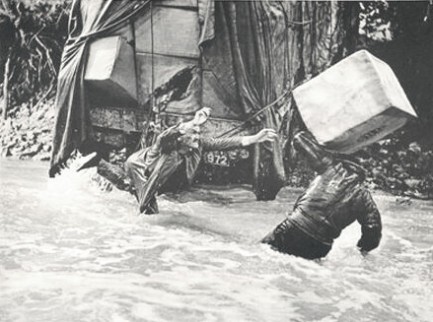 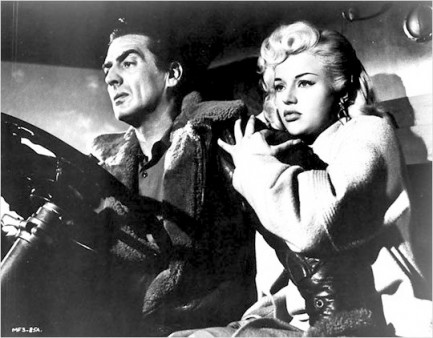 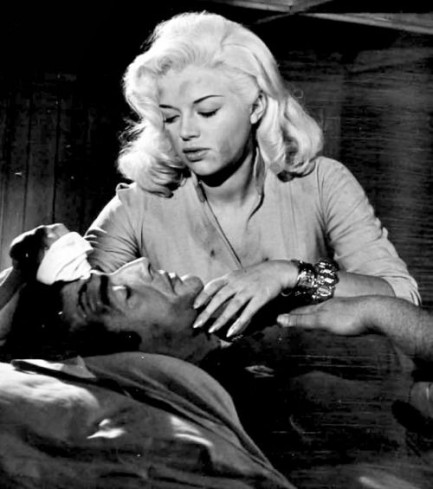 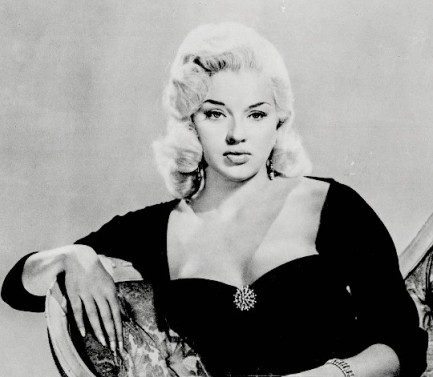
 It's shocking how many Hollywood stars did smack. 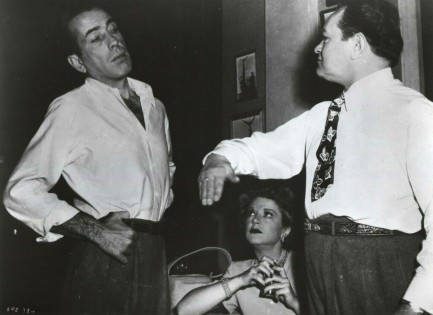
Everybody wants to slap somebody sometime. Luckily, actors in movies do it so you don't have to. The above shot is a good example. Edward G. Robinson lets Humphrey Bogart have it in 1948's Key Largo, as Claire Trevor looks on. In vintage cinema, people were constantly slapping. Men slapped men, men slapped women, women slapped women, and women slapped men. The recipient was usually the protagonist because—though some readers may not realize this—even during the ’40s and 50s, slapping was considered uncouth at a minimum, and downright villainous at worst, particularly when men did it. So generally, bad guys did the slapping, with some exceptions. Glenn Ford slaps Rita Hayworth in Gilda, for example, out of humiliation. Still wrong, but he wasn't the film's villain is our point. Humphrey Bogart lightly slaps Martha Vickers in The Big Sleep to bring her out of a drug stupor. He's like a doctor. Sort of. In any case, most cinematic slapping is fake, and when it wasn't it was done with the consent of the participants (No, really slap me! It'll look more realistic.). There are some famous examples of chipped teeth and bloody noses deriving from the pursuit of realism. We can envision a museum exhibit of photos like these, followed by a lot of conversation around film, social mores, masculinity, and their intersection. We can also envison a conversation around the difference between fantasy and reality. There are some who believe portryals of bad things endorse the same. But movies succeed largely by thrilling, shocking, and scaring audiences, which requires portraying thrilling, shocking, and frightening moments. If actors can't do that, then ultimately movies must become as banal as everyday llife. Enjoy the slapfest.
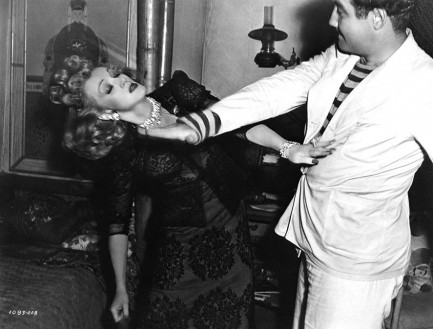 Broderick Crawford slaps Marlene Dietrich in the 1940's Seven Sinners. Broderick Crawford slaps Marlene Dietrich in the 1940's Seven Sinners.
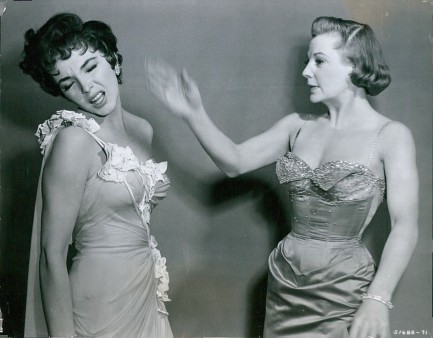 June Allyson lets Joan Collins have it across the kisser in a promo image for The Opposite Sex, 1956. June Allyson lets Joan Collins have it across the kisser in a promo image for The Opposite Sex, 1956.
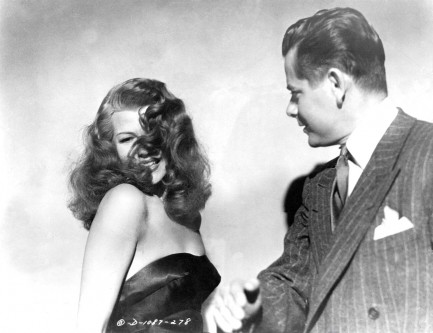 Speaking of Gilda, here's one of Glenn Ford and Rita Hayworth re-enacting the slap heard round the world. Hayworth gets to slap Ford too, and according to some accounts she loosened two of his teeth. We don't know if that's true, but if you watch the sequence it is indeed quite a blow. 100% real. We looked for a photo of it but had no luck. Speaking of Gilda, here's one of Glenn Ford and Rita Hayworth re-enacting the slap heard round the world. Hayworth gets to slap Ford too, and according to some accounts she loosened two of his teeth. We don't know if that's true, but if you watch the sequence it is indeed quite a blow. 100% real. We looked for a photo of it but had no luck.
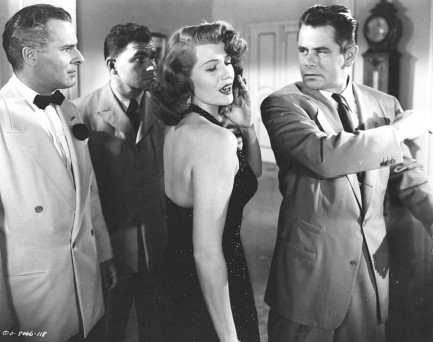 Don't mess with box office success. Ford and Hayworth did it again in 1952's Affair in Trinidad. Don't mess with box office success. Ford and Hayworth did it again in 1952's Affair in Trinidad.
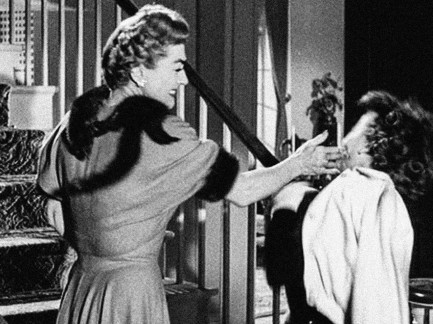 All-time film diva Joan Crawford gets in a good shot on Lucy Marlow in 1955's Queen Bee. All-time film diva Joan Crawford gets in a good shot on Lucy Marlow in 1955's Queen Bee.
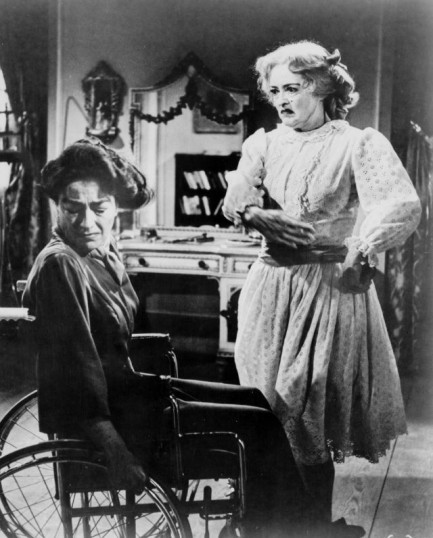 The answer to the forthcoming question is: She turned into a human monster, that's what. Joan Crawford is now on the receiving end, with Bette Davis issuing the slap in Whatever Happened to Baby Jane? Later Davis kicks Crawford, so the slap is just a warm-up. The answer to the forthcoming question is: She turned into a human monster, that's what. Joan Crawford is now on the receiving end, with Bette Davis issuing the slap in Whatever Happened to Baby Jane? Later Davis kicks Crawford, so the slap is just a warm-up.
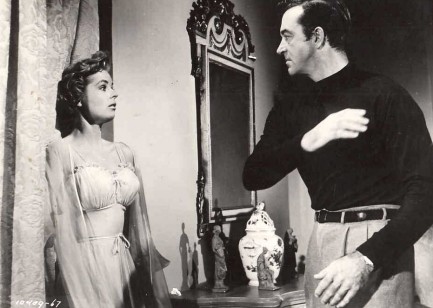 Mary Murphy awaits the inevitable from John Payne in 1955's Hell's Island. Mary Murphy awaits the inevitable from John Payne in 1955's Hell's Island.
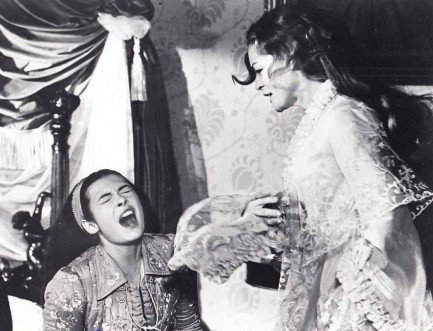 Romy Schneider slaps Sonia Petrova in 1972's Ludwig. Romy Schneider slaps Sonia Petrova in 1972's Ludwig.
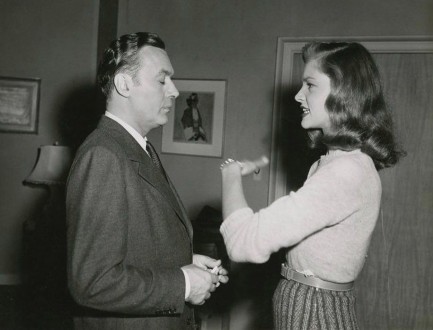 Lauren Bacall lays into Charles Boyer in 1945's Confidential Agent and garnishes the slap with a brilliant snarl. Lauren Bacall lays into Charles Boyer in 1945's Confidential Agent and garnishes the slap with a brilliant snarl.
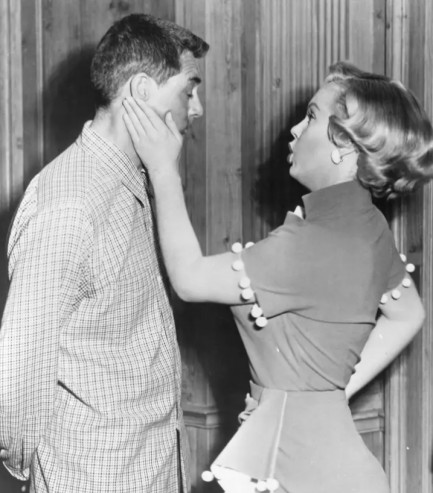 Iconic bombshell Marilyn Monroe drops a smart bomb on Cary Grant in the 1952 comedy Monkey Business. Iconic bombshell Marilyn Monroe drops a smart bomb on Cary Grant in the 1952 comedy Monkey Business.
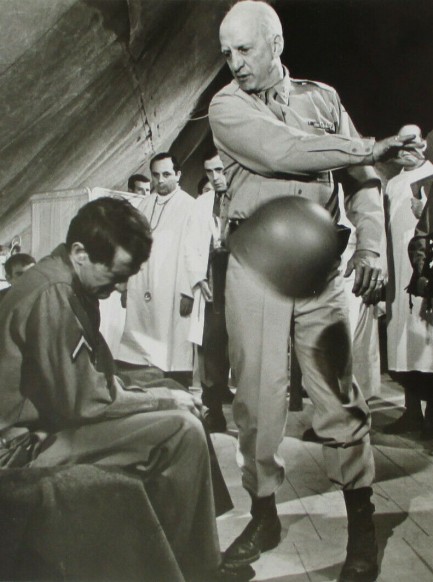 This is the most brutal slap of the bunch, we think, from 1969's Patton, as George C. Scott de-helmets an unfortunate soldier played by Tim Considine. This is the most brutal slap of the bunch, we think, from 1969's Patton, as George C. Scott de-helmets an unfortunate soldier played by Tim Considine.
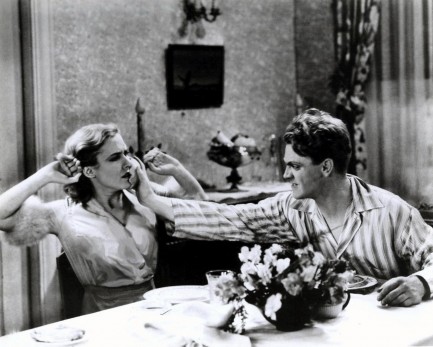 A legendary scene in filmdom is when James Cagney shoves a grapefruit in Mae Clark's face in The Public Enemy. Is it a slap? He does it pretty damn hard, so we think it's close enough. They re-enact that moment here in a promo photo made in 1931. A legendary scene in filmdom is when James Cagney shoves a grapefruit in Mae Clark's face in The Public Enemy. Is it a slap? He does it pretty damn hard, so we think it's close enough. They re-enact that moment here in a promo photo made in 1931.
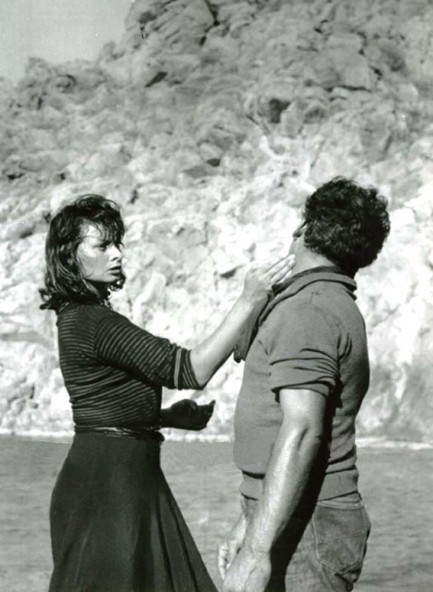 Sophia Loren gives Jorge Mistral a scenic seaside slap in 1957's Boy on a Dolphin. Sophia Loren gives Jorge Mistral a scenic seaside slap in 1957's Boy on a Dolphin.
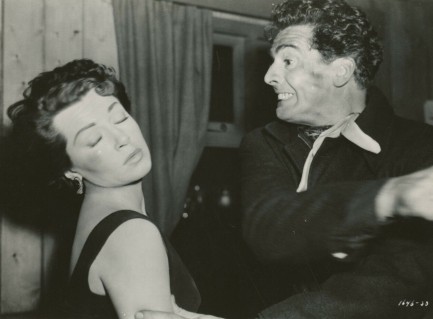 Victor Mature fails to live up to his last name as he slaps Lana Turner in 1954's Betrayed. Victor Mature fails to live up to his last name as he slaps Lana Turner in 1954's Betrayed. 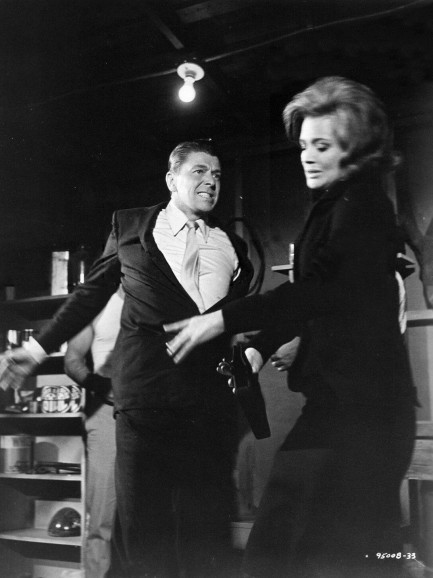 Ronald Reagan teaches Angie Dickinson how supply side economics work in 1964's The Killers. Ronald Reagan teaches Angie Dickinson how supply side economics work in 1964's The Killers.
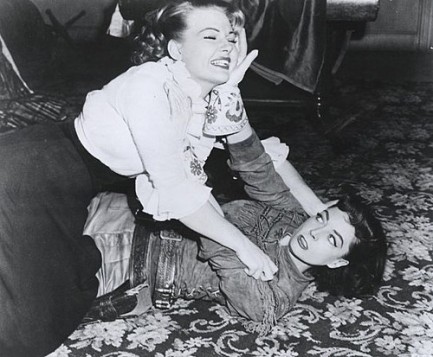 Marie Windsor gets in one against Mary Castle from the guard position in an episode of television's Stories of the Century in 1954. Windsor eventually won this bout with a rear naked choke. Marie Windsor gets in one against Mary Castle from the guard position in an episode of television's Stories of the Century in 1954. Windsor eventually won this bout with a rear naked choke.
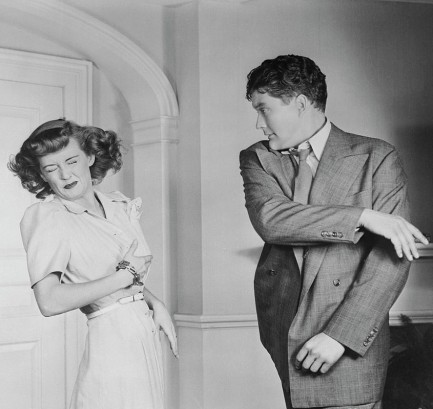 It's better to give than receive, but sadly it's Bette Davis's turn, as she takes one from Dennis Morgan in In This Our Life, 1942. It's better to give than receive, but sadly it's Bette Davis's turn, as she takes one from Dennis Morgan in In This Our Life, 1942.
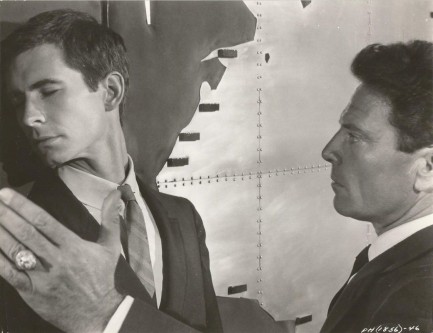 Anthony Perkins and Raf Vallone dance the dance in 1962's Phaedra, with Vallone taking the lead. Anthony Perkins and Raf Vallone dance the dance in 1962's Phaedra, with Vallone taking the lead.
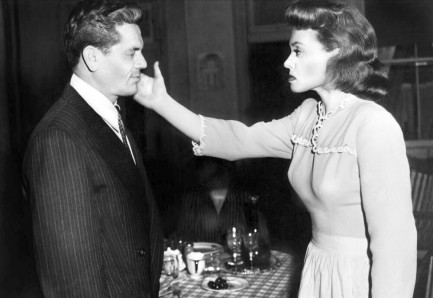 And he thought being inside the ring was hard. Lilli Palmer nails John Garfield with a roundhouse right in the 1947 boxing classic Body and Soul. And he thought being inside the ring was hard. Lilli Palmer nails John Garfield with a roundhouse right in the 1947 boxing classic Body and Soul.
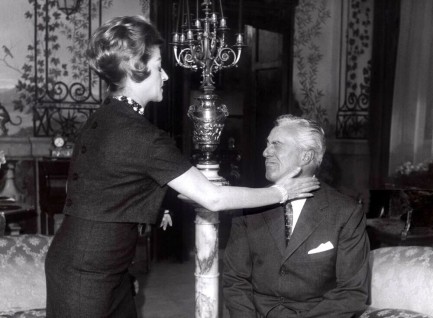 1960's Il vigile, aka The Mayor, sees Vittorio De Sica rebuked by a member of the electorate Lia Zoppelli. She's more than a voter in this—she's also his wife, so you can be sure he deserved it. 1960's Il vigile, aka The Mayor, sees Vittorio De Sica rebuked by a member of the electorate Lia Zoppelli. She's more than a voter in this—she's also his wife, so you can be sure he deserved it.
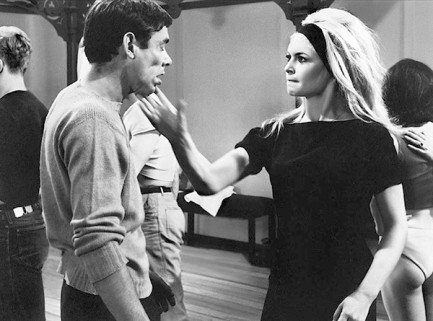 Brigitte Bardot delivers a not-so-private slap to Dirk Sanders in 1962's Vie privée, aka A Very Private Affair. Brigitte Bardot delivers a not-so-private slap to Dirk Sanders in 1962's Vie privée, aka A Very Private Affair.
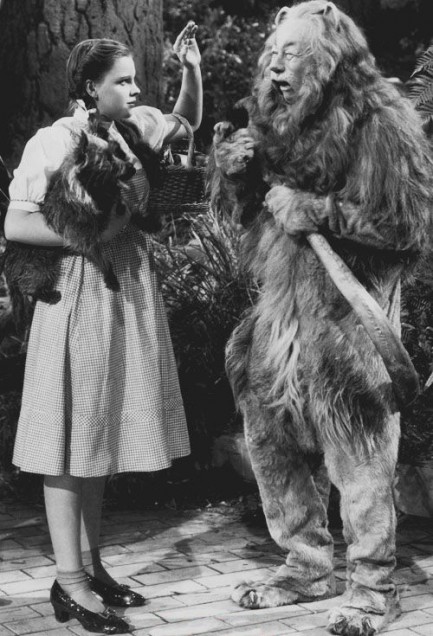 In a classic case of animal abuse. Judy Garland gives cowardly lion Bert Lahr a slap on the nose in The Wizard of Oz. Is it his fault he's a pussy? Accept him as he is, Judy. In a classic case of animal abuse. Judy Garland gives cowardly lion Bert Lahr a slap on the nose in The Wizard of Oz. Is it his fault he's a pussy? Accept him as he is, Judy.
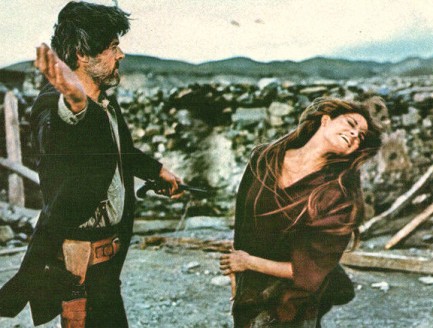 Robert Culp backhands Raquel Welch in 1971's Hannie Caudler. Robert Culp backhands Raquel Welch in 1971's Hannie Caudler.
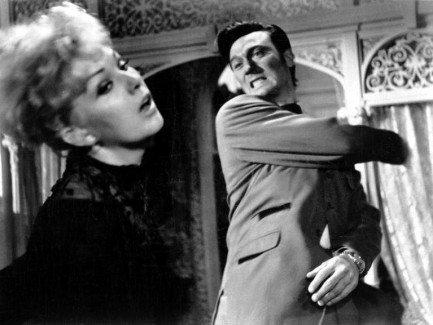 And finally, Laurence Harvey dares to lay hands on the perfect Kim Novak in Of Human Bondage. And finally, Laurence Harvey dares to lay hands on the perfect Kim Novak in Of Human Bondage.
 St. Cyr tells all for the cheapie tabloid Midnight. 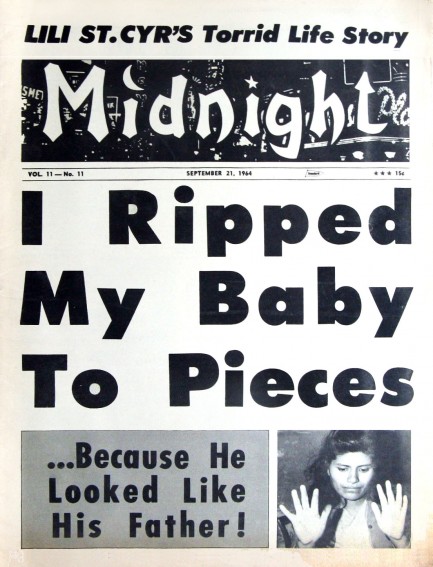
This Midnight published today in 1964 has the usual clickbait on the front cover—I Ripped My Baby To Pieces. Why? Because she hated her husband. Very interesting, but today we're drawn to the banner and Lili St. Cyr's “Torrid Life Story,” in which, for the most part, she talks about her sexual attitudes. The interior header screams that she seduced a 14-year-old boy, and that's again the equivalent of today's internet clickbait. St. Cyr was sixteen herself, which is an age difference we'd hardly call scandalous. The clickbait worked, though. It made us quite eager to read the story. It's written in first person and touted as a Midnight exclusive.
Ordinarily we'd be skeptical a cheapie tabloid could score an exclusive with a world famous celebrity, but in this case we think Midnight is telling the truth. We have a few reasons: Midnight was a Canadian rag, headquartered in Montreal; St. Cyr was from Minnesota, but spent her early years dancing in Montreal; and Midnight was too well known a publication to get away with lying about the source of the story. Thus we can be sure St. Cyr wrote the piece. She eventually authored an autobiography in French, which makes us suspect she wrote this article 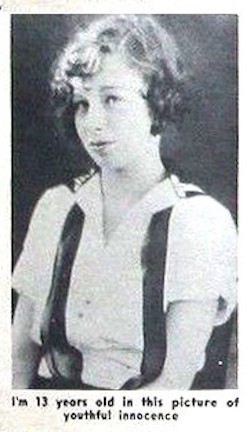 for the Canadian Midnight—which was called Minuit—and it was translated and printed in the U.S. later. Just a guess. It was apparently part of a series, by the way, but we don't have the other issues of Midnight. Now on to the juicy stuff. for the Canadian Midnight—which was called Minuit—and it was translated and printed in the U.S. later. Just a guess. It was apparently part of a series, by the way, but we don't have the other issues of Midnight. Now on to the juicy stuff.
On virginity: “When you have it you try like hell to keep it. You lose it with an unconscious sigh of relief, and once you've lost it you wonder why you tried so hard to keep it in the first place.”
On her first: “Right now, as I write these lines, [all I] can recall about him is that he was blonde and his first name began with an R. As a matter of fact, I don't remember any of my first intimate boyfriends.”
On her others: “I've been called a child snatcher dozens of times because that is the way I like my men. I can't help it.”
On Hollywood star Victor Mature: “One bad thing about Vic though. Liquor and sex just don't mix for him. If he makes love, he's got to be cold sober or he can't perform.”
On Las Vegas: “There is something dead and decadent about the town. It builds to nowhere. It accomplishes nothing. And the people in it are infected with this live-for-today attitude.”
 Those are the highlights. Except that readers also get three photos with the article. We already shared a much better version of one of those way back in 2009. The other two are in this post—the shot of St. Cyr as a child, when she was still Willis Marie Van Schaack, and the one below of her in goddess mode. Midnight was printed on cheap-ass paper, but the scans still look pretty good. Willis Marie's tale is interesting too. She was ahead of her time. What she writes could have been written by a character on Girls. It's impossible for us to not respect her boldness and determination to have exactly the life she wanted, particularly during the age in which she lived. We have plenty on St. Cyr in the website. Just click her keywords below. Those are the highlights. Except that readers also get three photos with the article. We already shared a much better version of one of those way back in 2009. The other two are in this post—the shot of St. Cyr as a child, when she was still Willis Marie Van Schaack, and the one below of her in goddess mode. Midnight was printed on cheap-ass paper, but the scans still look pretty good. Willis Marie's tale is interesting too. She was ahead of her time. What she writes could have been written by a character on Girls. It's impossible for us to not respect her boldness and determination to have exactly the life she wanted, particularly during the age in which she lived. We have plenty on St. Cyr in the website. Just click her keywords below. 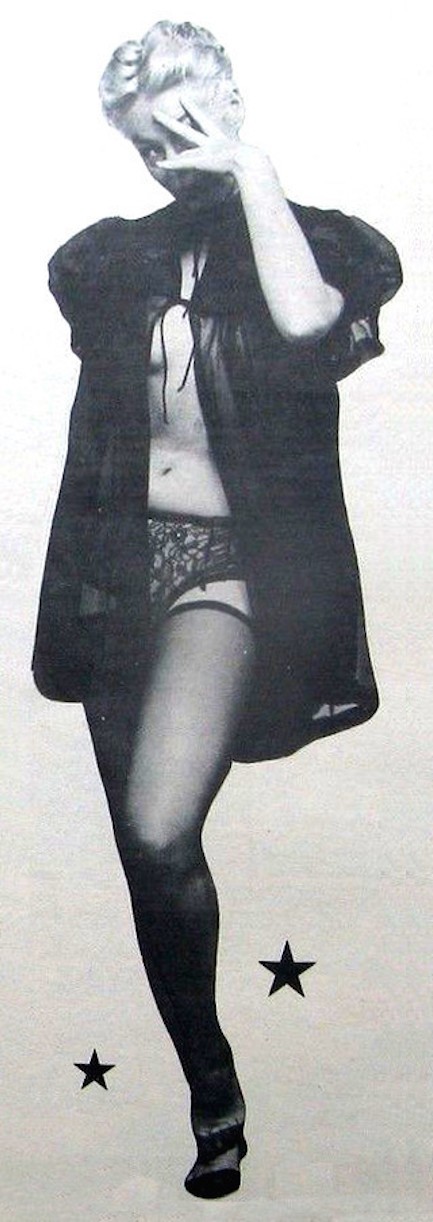
 You spend all week looking forward to Saturday and then this happens. 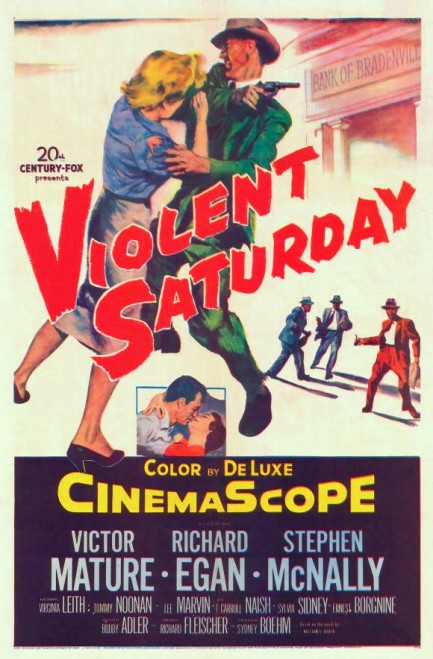
In Violent Saturday, a group of people are loosely connected to a smalltown bank that has been targeted by a trio of robbers. Yes, it's a heist double feature at the Noir City Film Festival. We meet the big shot at a local mine who is one of the bank's most important customers. We meet his cheating wife, who's having an affair with a bank employee. We're introduced to a group of Amish who have no idea their nearby community has been chosen as a rendezvous point. We get to know the bank manager—and the woman whose window he peeps through at night. As you might guess from our rundown, the examination of all these characters and their situations is detailed. In fact, it lasts two thirds of the film. When the bank is finally robbed, some of these people will find themselves in the wrong place at the wrong time as the criminals' careful plan degenerates into a kill-or-be-killed fiasco. Lethal results are coming but we have no idea who will survive. Everyone is flawed, everyone has hope for a good future, but not all of them will get to see it. Violent Saturday is a DeLuxe color production rather than a standard black and white film noir. Set in Arizona, it was dubbed "southwestern noir" by the Village Voice, but really it's just a tidy little thriller—with an untidy little finish. We think it fits nicely on the Noir City slate. 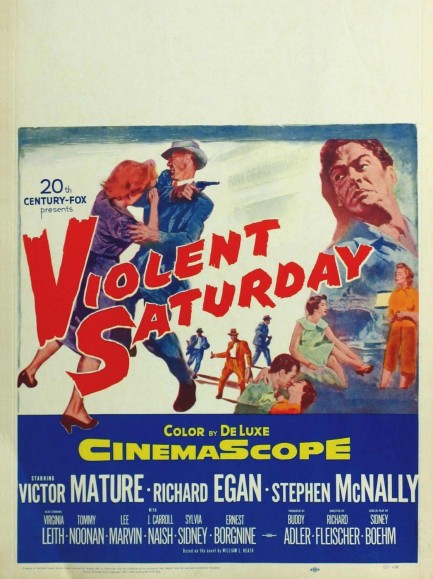
 Anita Ekberg single-handedly changes the ethnic makeup of an entire country. 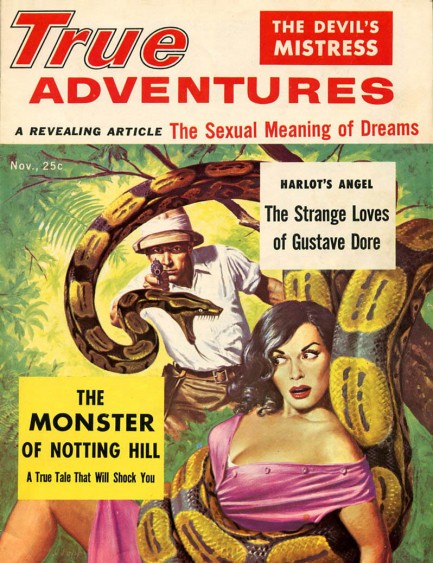
The cover of this November 1956 issue of True Adventures is great by itself, but as a bonus readers are treated inside to a photo feature on superstar Anita Ekberg, who had been filming the adventure flick Zarak, aka Zarak Khan. The movie concerned the exploits of an Afghani outlaw (or resistance fighter, depending on one’s point of view), and Ekberg, rather amusingly, played an Afghani girl named Salma. Criticisms were voiced concerning the blue-eyed Swede’s casting in the role, but these rang hollow, considering the presence of Kentucky-born Victor Mature in the lead. In any case, the film’s producers Irving Allen and Cubby Broccoli didn’t care if Ekberg made an unlikely Afghan—to them having her shimmy around in a midriff-baring harem outfit was worth it. Were they right? You can be the judge of that for yourself by checking this link. 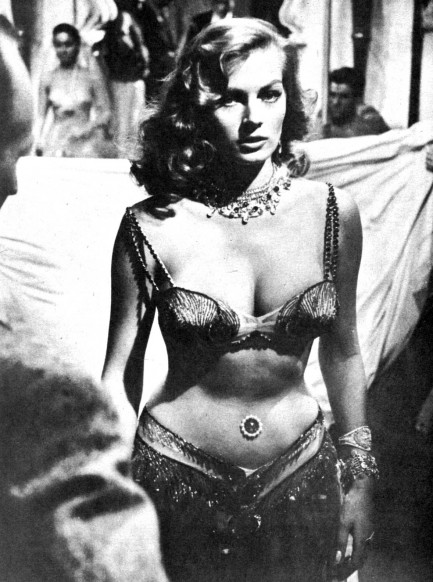 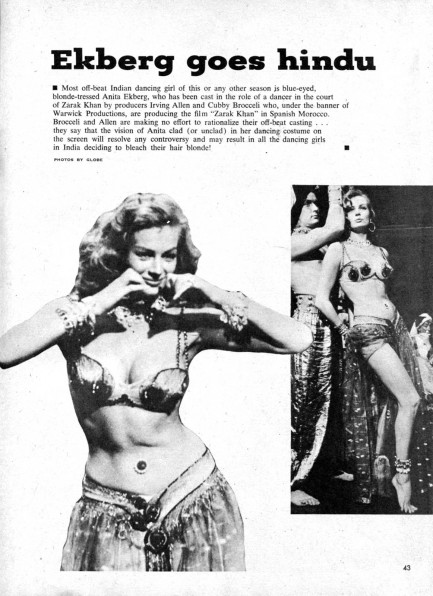 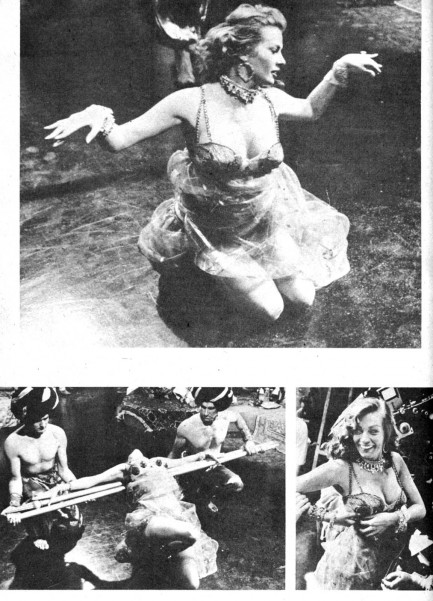 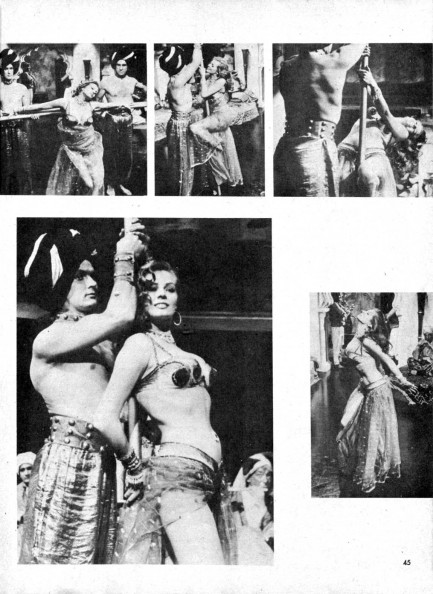
 There’s just no escaping the past. 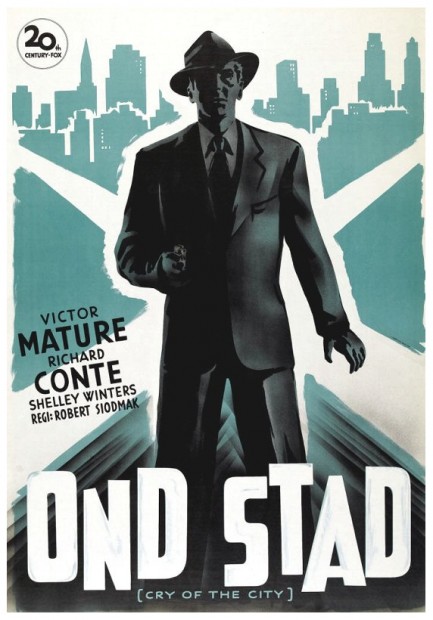
This understated but great poster was made for the Swedish release of Robert Siodmak’s film noir Cry of the City, which starred Victor Mature. In Sweden it was retitled Ond stad, which means “vicious city,” and in getting across that idea we like how the art positions Mature atop an X, or perhaps a crossroads, which we guess represents his presence at the center of a clash of difficult circumstances. This is a great movie that we talked about in detail back in 2009, and today we’re reiterating that it’s one to see. It opened in Sweden today in 1948.

|
 |

The headlines that mattered yesteryear.
2003—Hope Dies
Film legend Bob Hope dies of pneumonia two months after celebrating his 100th birthday. 1945—Churchill Given the Sack
In spite of admiring Winston Churchill as a great wartime leader, Britons elect
Clement Attlee the nation's new prime minister in a sweeping victory for the Labour Party over the Conservatives. 1952—Evita Peron Dies
Eva Duarte de Peron, aka Evita, wife of the president of the Argentine Republic, dies from cancer at age 33. Evita had brought the working classes into a position of political power never witnessed before, but was hated by the nation's powerful military class. She is lain to rest in Milan, Italy in a secret grave under a nun's name, but is eventually returned to Argentina for reburial beside her husband in 1974. 1943—Mussolini Calls It Quits
Italian dictator Benito Mussolini steps down as head of the armed forces and the government. It soon becomes clear that Il Duce did not relinquish power voluntarily, but was forced to resign after former Fascist colleagues turned against him. He is later installed by Germany as leader of the Italian Social Republic in the north of the country, but is killed by partisans in 1945.
|

|
|

It's easy. We have an uploader that makes it a snap. Use it to submit your art, text, header, and subhead. Your post can be funny, serious, or anything in between, as long as it's vintage pulp. You'll get a byline and experience the fleeting pride of free authorship. We'll edit your post for typos, but the rest is up to you. Click here to give us your best shot.

|
|

























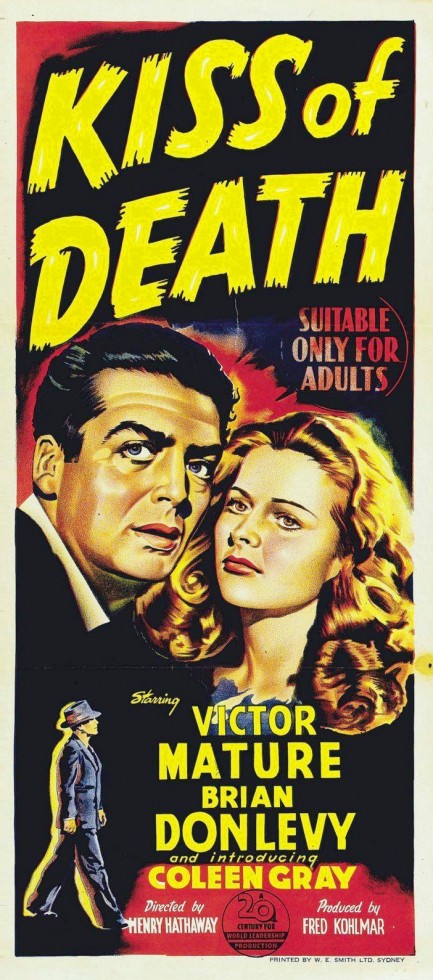
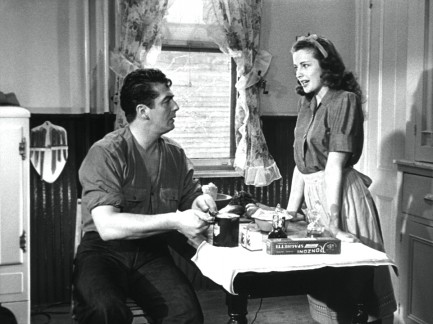
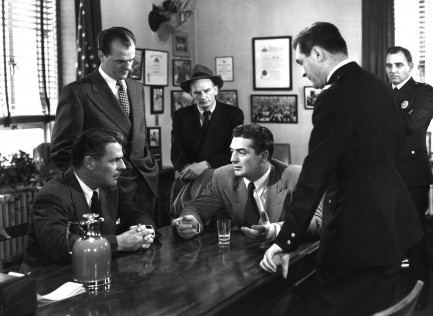
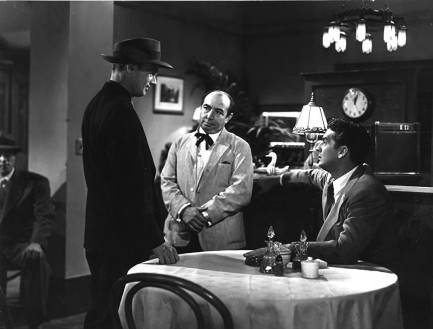
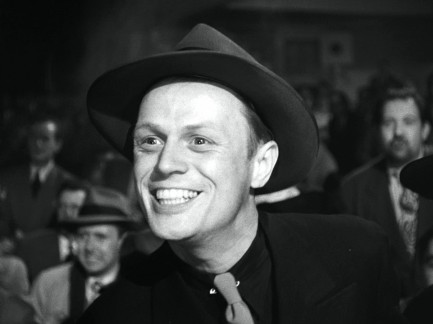
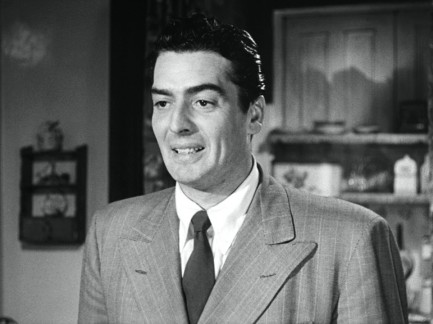
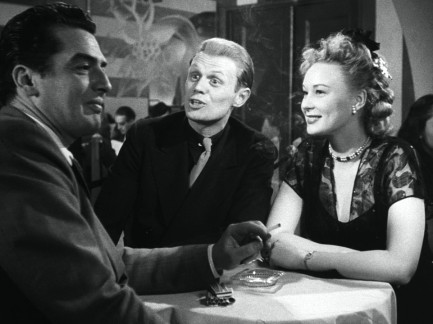
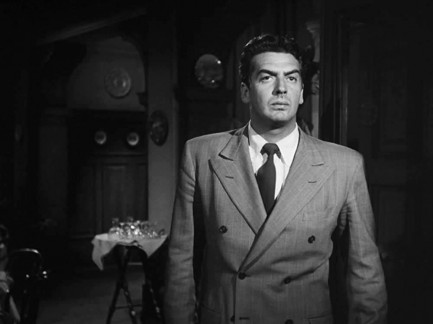
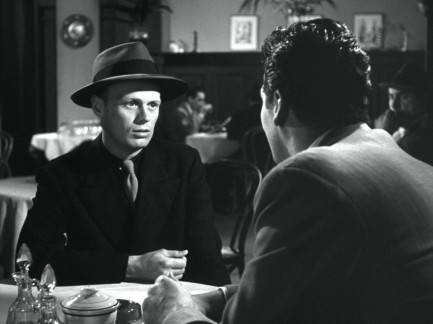
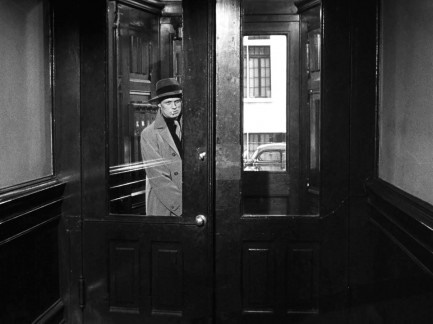
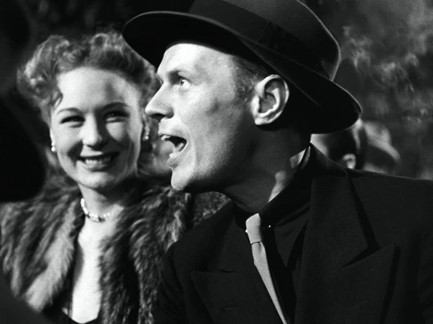
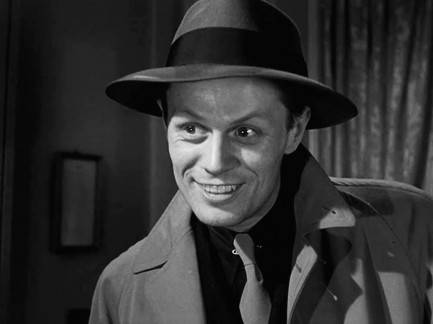
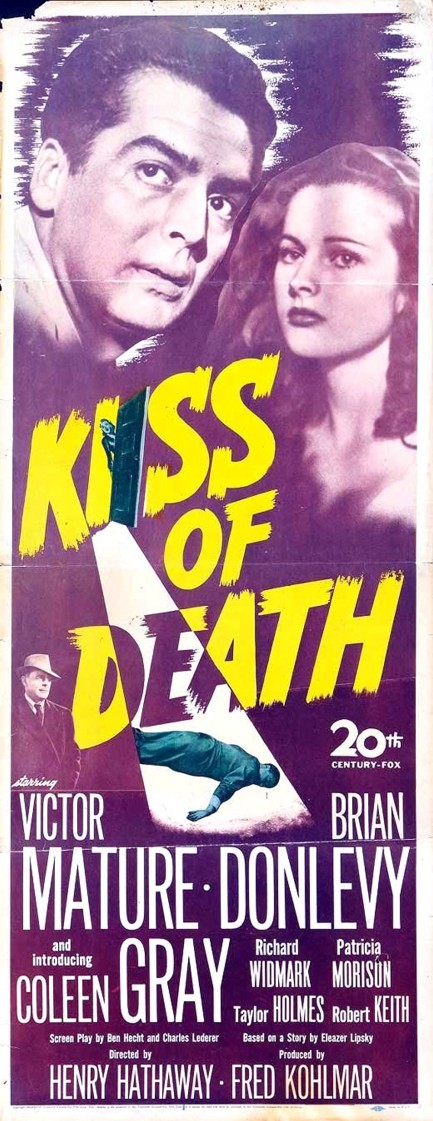


 Broderick Crawford slaps Marlene Dietrich in the 1940's Seven Sinners.
Broderick Crawford slaps Marlene Dietrich in the 1940's Seven Sinners. June Allyson lets Joan Collins have it across the kisser in a promo image for The Opposite Sex, 1956.
June Allyson lets Joan Collins have it across the kisser in a promo image for The Opposite Sex, 1956. Speaking of Gilda, here's one of Glenn Ford and Rita Hayworth re-enacting the slap heard round the world. Hayworth gets to slap Ford too, and according to some accounts she loosened two of his teeth. We don't know if that's true, but if you watch the sequence it is indeed quite a blow. 100% real. We looked for a photo of it but had no luck.
Speaking of Gilda, here's one of Glenn Ford and Rita Hayworth re-enacting the slap heard round the world. Hayworth gets to slap Ford too, and according to some accounts she loosened two of his teeth. We don't know if that's true, but if you watch the sequence it is indeed quite a blow. 100% real. We looked for a photo of it but had no luck. Don't mess with box office success. Ford and Hayworth did it again in 1952's Affair in Trinidad.
Don't mess with box office success. Ford and Hayworth did it again in 1952's Affair in Trinidad. All-time film diva Joan Crawford gets in a good shot on Lucy Marlow in 1955's Queen Bee.
All-time film diva Joan Crawford gets in a good shot on Lucy Marlow in 1955's Queen Bee. The answer to the forthcoming question is: She turned into a human monster, that's what. Joan Crawford is now on the receiving end, with Bette Davis issuing the slap in Whatever Happened to Baby Jane? Later Davis kicks Crawford, so the slap is just a warm-up.
The answer to the forthcoming question is: She turned into a human monster, that's what. Joan Crawford is now on the receiving end, with Bette Davis issuing the slap in Whatever Happened to Baby Jane? Later Davis kicks Crawford, so the slap is just a warm-up. Mary Murphy awaits the inevitable from John Payne in 1955's Hell's Island.
Mary Murphy awaits the inevitable from John Payne in 1955's Hell's Island. Romy Schneider slaps Sonia Petrova in 1972's Ludwig.
Romy Schneider slaps Sonia Petrova in 1972's Ludwig. Lauren Bacall lays into Charles Boyer in 1945's Confidential Agent and garnishes the slap with a brilliant snarl.
Lauren Bacall lays into Charles Boyer in 1945's Confidential Agent and garnishes the slap with a brilliant snarl. Iconic bombshell Marilyn Monroe drops a smart bomb on Cary Grant in the 1952 comedy Monkey Business.
Iconic bombshell Marilyn Monroe drops a smart bomb on Cary Grant in the 1952 comedy Monkey Business. This is the most brutal slap of the bunch, we think, from 1969's Patton, as George C. Scott de-helmets an unfortunate soldier played by Tim Considine.
This is the most brutal slap of the bunch, we think, from 1969's Patton, as George C. Scott de-helmets an unfortunate soldier played by Tim Considine. A legendary scene in filmdom is when James Cagney shoves a grapefruit in Mae Clark's face in The Public Enemy. Is it a slap? He does it pretty damn hard, so we think it's close enough. They re-enact that moment here in a promo photo made in 1931.
A legendary scene in filmdom is when James Cagney shoves a grapefruit in Mae Clark's face in The Public Enemy. Is it a slap? He does it pretty damn hard, so we think it's close enough. They re-enact that moment here in a promo photo made in 1931. Sophia Loren gives Jorge Mistral a scenic seaside slap in 1957's Boy on a Dolphin.
Sophia Loren gives Jorge Mistral a scenic seaside slap in 1957's Boy on a Dolphin. Victor Mature fails to live up to his last name as he slaps Lana Turner in 1954's Betrayed.
Victor Mature fails to live up to his last name as he slaps Lana Turner in 1954's Betrayed. Ronald Reagan teaches Angie Dickinson how supply side economics work in 1964's The Killers.
Ronald Reagan teaches Angie Dickinson how supply side economics work in 1964's The Killers. Marie Windsor gets in one against Mary Castle from the guard position in an episode of television's Stories of the Century in 1954. Windsor eventually won this bout with a rear naked choke.
Marie Windsor gets in one against Mary Castle from the guard position in an episode of television's Stories of the Century in 1954. Windsor eventually won this bout with a rear naked choke. It's better to give than receive, but sadly it's Bette Davis's turn, as she takes one from Dennis Morgan in In This Our Life, 1942.
It's better to give than receive, but sadly it's Bette Davis's turn, as she takes one from Dennis Morgan in In This Our Life, 1942. Anthony Perkins and Raf Vallone dance the dance in 1962's Phaedra, with Vallone taking the lead.
Anthony Perkins and Raf Vallone dance the dance in 1962's Phaedra, with Vallone taking the lead. And he thought being inside the ring was hard. Lilli Palmer nails John Garfield with a roundhouse right in the 1947 boxing classic Body and Soul.
And he thought being inside the ring was hard. Lilli Palmer nails John Garfield with a roundhouse right in the 1947 boxing classic Body and Soul. 1960's Il vigile, aka The Mayor, sees Vittorio De Sica rebuked by a member of the electorate Lia Zoppelli. She's more than a voter in this—she's also his wife, so you can be sure he deserved it.
1960's Il vigile, aka The Mayor, sees Vittorio De Sica rebuked by a member of the electorate Lia Zoppelli. She's more than a voter in this—she's also his wife, so you can be sure he deserved it. Brigitte Bardot delivers a not-so-private slap to Dirk Sanders in 1962's Vie privée, aka A Very Private Affair.
Brigitte Bardot delivers a not-so-private slap to Dirk Sanders in 1962's Vie privée, aka A Very Private Affair. In a classic case of animal abuse. Judy Garland gives cowardly lion Bert Lahr a slap on the nose in The Wizard of Oz. Is it his fault he's a pussy? Accept him as he is, Judy.
In a classic case of animal abuse. Judy Garland gives cowardly lion Bert Lahr a slap on the nose in The Wizard of Oz. Is it his fault he's a pussy? Accept him as he is, Judy. Robert Culp backhands Raquel Welch in 1971's Hannie Caudler.
Robert Culp backhands Raquel Welch in 1971's Hannie Caudler. And finally, Laurence Harvey dares to lay hands on the perfect Kim Novak in Of Human Bondage.
And finally, Laurence Harvey dares to lay hands on the perfect Kim Novak in Of Human Bondage. 

 for the Canadian Midnight—which was called Minuit—and it was translated and printed in the U.S. later. Just a guess. It was apparently part of a series, by the way, but we don't have the other issues of Midnight. Now on to the juicy stuff.
for the Canadian Midnight—which was called Minuit—and it was translated and printed in the U.S. later. Just a guess. It was apparently part of a series, by the way, but we don't have the other issues of Midnight. Now on to the juicy stuff. Those are the highlights. Except that readers also get three photos with the article. We already shared a much better version of one of those way back in 2009. The other two are in this post—the shot of St. Cyr as a child, when she was still Willis Marie Van Schaack, and the one below of her in goddess mode. Midnight was printed on cheap-ass paper, but the scans still look pretty good. Willis Marie's tale is interesting too. She was ahead of her time. What she writes could have been written by a character on Girls. It's impossible for us to not respect her boldness and determination to have exactly the life she wanted, particularly during the age in which she lived. We have plenty on St. Cyr in the website. Just click her keywords below.
Those are the highlights. Except that readers also get three photos with the article. We already shared a much better version of one of those way back in 2009. The other two are in this post—the shot of St. Cyr as a child, when she was still Willis Marie Van Schaack, and the one below of her in goddess mode. Midnight was printed on cheap-ass paper, but the scans still look pretty good. Willis Marie's tale is interesting too. She was ahead of her time. What she writes could have been written by a character on Girls. It's impossible for us to not respect her boldness and determination to have exactly the life she wanted, particularly during the age in which she lived. We have plenty on St. Cyr in the website. Just click her keywords below.
















































































